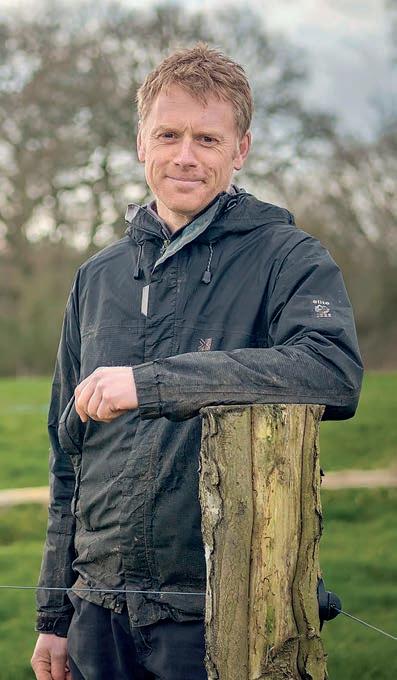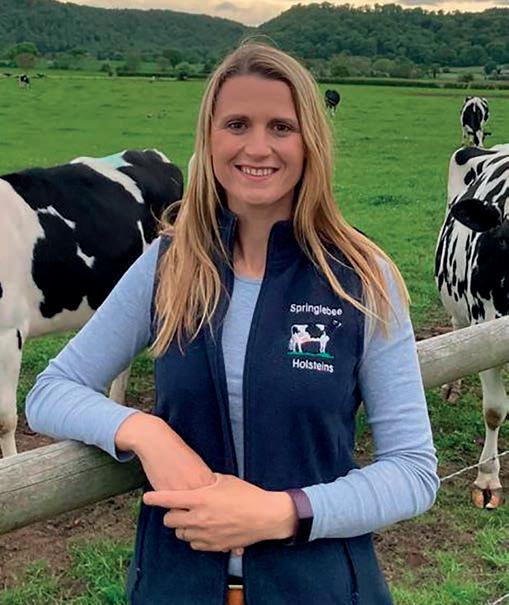
6 minute read
DAIRY TALK
DAIRYTalk
Dan Burdett
Dan and his family own and run the 300-hectare (741-acre) Cockhaise Farm, near Haywards Heath, West Sussex. The farm is home to an organic autumn-calving herd of 240 Holstein and Friesian crosses. He also contract farms another organic autumn-calving herd of 220 cows at Bore Place, near Edenbridge, Kent.
Although you will be reading this in September, I am currently writing this in mid-July, with temperatures knocking on the door of 40degC and my feet in a cold bucket of water to stave o self-combustion in my tropical o ce.
Although the temperatures are certainly on the high side, we are fortunate it is only really for a couple of days, before normal summer weather resumes later this week.
In recent months, I have spent more and more time looking at the cost of running an autumn calving herd through winter, with ever-escalating feed costs making the production of milk uneconomic.
However, with every dry summer we receive, I feel relieved we are able to dry all of the cows o to far ung corners of the farm onto standing hay, therefore taking the pressure o the grazing platform.
As a simple self-feed farm, we are just not set up for bu er feeding, so the ability to stockpile grass through the good months to feed out now is our saving grace.
I have been fortunate enough to have had several groups of farmers and advisers here over the last month, although by the 10th visit the well-trodden route around the farm was looking a bit worse for wear.
I love the challenge of hearing honest views on what we are doing here. It is important I am able to come out of my comfort zone in order to keep on making progress.
Topics for discussion included the breeding of our cows, with question marks as to whether they really were the same 550kg average as when weighed four years ago.
Benefits
We have nailed our colours rmly to the Irish Holstein Friesian mast over the last seven years and we have seen the bene ts of improved fertility and constituents, but I can’t a ord to milk bigger cows, particularly on an organic system, so will be weighing cows this winter to make sure we are still on the right track.
One of the other main talking points was slurry handling and the confusion over upcoming legislation and how that a ects what we do on the ground on our individual farms. At Cockhaise we have a lagoon which wraps around our cubicle shed, so completely incompatible with any sort of cover system.
We also use straw for bedding which then needs to be dug out once a year, again, not compatible with a cover.
We also use a Briggs irrigator to apply the watery slurry that comes through the weeping wall, a system which enables us to follow the cows round during the grazing season. But will this be allowable?
One thing for sure is that at some point in the near future we will need to invest signi cant capital in order to continue dairy farming, but for the time being I am happy to watch and wait, both for the clari cation on the rules, but also how other farms tackle these issues.
Before we start calving later in August, I am o for two weeks of yet more heat in Corfu. Having had our last three years of holidays cancelled, this is long overdue and a great opportunity to leave the farm, turn o my phone and have some much needed R and R.
As the challenges become greater in the coming years, it is really important to look a er yourself and those around you.
Becky Fenton
Becky Fenton and husband Paul milk 200 pedigree Holsteins under the Springlebee prefix at Centenary Farm, a Cheshire county council farm. In 2021, they bought a farm in Staffordshire and they plan to farm there once the new dairy set-up has been built.
Istart this column with achievement. A er several years out of the show circle, we decided it was time to get back out there. So at the end of July we a ended our local agricultural show, Nantwich Show. e show has been cancelled the previous three years and was newly relocated this year. We decided to take just one third calved cow and three calves for our boys to show.
I am pleased to say we came away with overall supreme dairy championship. is is something that we are proud of and the rst time we have achieved this accolade in our showing history.
All three of our boys took calves into the showmanship class and our eldest son took home the award for champion calf handler.
We have always been fond of showing and I can appreciate a good cow, but two things I always remember about judging of any kind really is ‘it is only one person’s opinion’ and ‘is it best to have one amazing cow for everyone to see at a show or a good uniform herd of unrecognised cows at home?’
Engagement
One thing myself and fellow exhibitors noticed at Nantwich Show was there was a real engagement and interest in the livestock from the general public. We were happy to answer questions they had and let them stroke the animals. We sometimes take for granted how lucky our children are to grow up on a farm. A farmer once said to me ‘if you have not lived on a farm you have not lived at all’.
Since our farming journey began, we have always been keen to build our portfolio. is has always proved us well when applying for farms and other opportunities.
We recently entered the Cheshire Farms Competition and were fortunate to win two classes and were awarded rst prize in the ‘combined west and east Cheshire county farms’ class and also the and ‘dairy herd black and white’ class. is led us to be in with a chance in the overall supreme competition. Unfortunately we did not win but I would like to congratulate the Beck family of Sandbach on their success. We a ended their open evening and it demonstrated that they were worthy winners.
Here at Centenary Farm, we graze our cows day and night in the summer months, alongside silage fed twice daily.
In normal circumstances we have enough grass in front of them to rotate elds. However, in June and July we experienced exceptionally dry months with very limited rainfall and therefore limited grass.
We were forced to open rst cut silage and bu er feed 8kg of brewers’ grains and 1kg of blend. Adding moisture and palatability to the diet li ed intake and resulted in an increase of 2.8 litres per cow. at said we have nally had a downpour of rain and now ceased the blend. ird cut silage was minimal and disappointing due to the weather. Fourth cut is looking more promising and bulking up well. And we have shut o grazed elds for extra silage.
We recently completed our carbon footprint assessment, it was relatively painless, some might think pointless. Our next inspection is from the Environment Agency, who are carrying out routine visits in Cheshire to see if we are complying with regulations and discuss ways to protect the environment.
Meanwhile, I strive to get through the summer holidays without loosing the plot.











